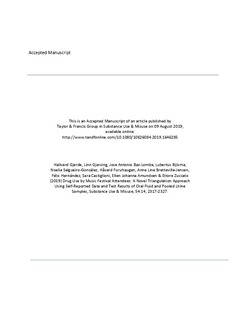| dc.contributor.author | Gjerde, Hallvard | |
| dc.contributor.author | Gjersing, Linn | |
| dc.contributor.author | Baz-Lomba, Jose Antonio | |
| dc.contributor.author | Bijlsma, Lubertus | |
| dc.contributor.author | Salgueiro-González, Noelia | |
| dc.contributor.author | Furuhaugen, Håvard | |
| dc.contributor.author | Bretteville-Jensen, Anne Line | |
| dc.contributor.author | Hernández, Félix | |
| dc.contributor.author | Castiglioni, Sara | |
| dc.contributor.author | Amundsen, Ellen Johanna | |
| dc.contributor.author | Zuccato, Ettore | |
| dc.date.accessioned | 2020-01-24T08:22:43Z | |
| dc.date.available | 2020-01-24T08:22:43Z | |
| dc.date.created | 2019-12-04T12:29:23Z | |
| dc.date.issued | 2019 | |
| dc.identifier.citation | Substance Use & Misuse. 2019, 54 (14), 2317-2327. | nb_NO |
| dc.identifier.issn | 1082-6084 | |
| dc.identifier.uri | http://hdl.handle.net/11250/2637741 | |
| dc.description | Embargo until 09 August 2020 | nb_NO |
| dc.description.abstract | Background: Self-reported data are commonly used when investigating illicit substance use. However, self-reports have well-known limitations such as limited recall and socially desirable responding. Mislabeling or adulteration of drugs on the illicit market may also cause incorrect reporting. Objectives: We aimed to examine what could be gained in terms of illicit drug use findings among music festival attendees when including biological sample test results in the assessment. Methods: We included 651 attendees at three music festivals in Norway from June to August 2016. Self-reported drug use was recorded using questionnaires, and samples of oral fluid were analyzed to detect use of illicit drugs. In addition, we analyzed samples of pooled urine from portable toilets at each festival. Results: All methods identified cannabis, MDMA, and cocaine as the most commonly used drugs. Overall, 6.6% of respondents reported use of illicit substances during the previous 48 hours. Oral fluid testing identified a larger number of drug users as 12.6% tested positive for illicit drugs. In oral fluid testing, we identified ketamine and three new psychoactive substances (NPS) that had not been reported on the questionnaire. In pooled urine testing, we identified amphetamine and three additional NPS that were neither reported used nor found in oral fluid samples. Conclusions/Importance: Drug testing of biological samples proved to be an important supplement to self-reports as a larger number of illicit substances could be detected. | nb_NO |
| dc.language.iso | eng | nb_NO |
| dc.publisher | Taylor & Francis | nb_NO |
| dc.title | Drug Use by Music Festival Attendees: A Novel Triangulation Approach Using Self-Reported Data and Test Results of Oral Fluid and Pooled Urine Samples | nb_NO |
| dc.type | Journal article | nb_NO |
| dc.type | Peer reviewed | nb_NO |
| dc.description.version | acceptedVersion | nb_NO |
| dc.source.pagenumber | 2317-2327 | nb_NO |
| dc.source.volume | 54 | nb_NO |
| dc.source.journal | Substance Use & Misuse | nb_NO |
| dc.source.issue | 14 | nb_NO |
| dc.identifier.doi | 10.1080/10826084.2019.1646285 | |
| dc.identifier.cristin | 1756528 | |
| cristin.unitcode | 7464,30,21,0 | |
| cristin.unitname | Miljøkjemi | |
| cristin.ispublished | true | |
| cristin.fulltext | postprint | |
| cristin.qualitycode | 1 | |
